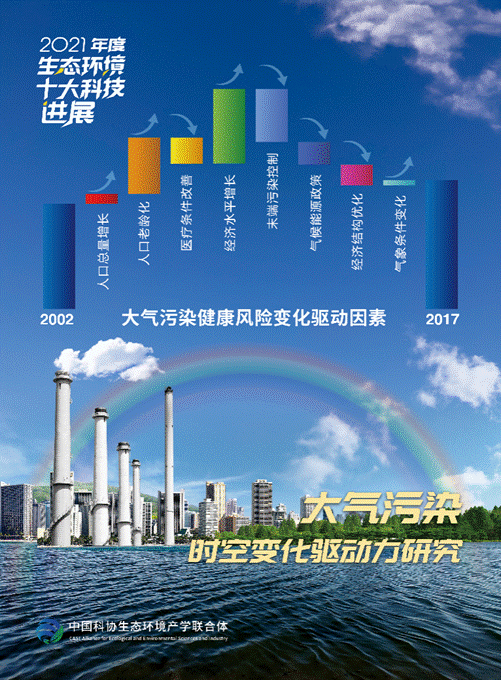On June 5, 2022, the World Environment Day, the Alliance of CAST Member Societies in Ecological Environment (hereinafter referred to as "the Alliance") announced China’s 2021 top 10 scientific and technological advances in ecological environment. The top 10 advances were recommended by academicians of the Chinese Academy of Sciences (CAS) and the Chinese Academy of Engineering (CAE), together with member societies of the Alliance, and research institutions, and were announced, evaluated and finally voted by a jury board composed of academicians and experts. The rating of the top ten advances aims to reflect the frontier development trends in China's ecological environment science and technology, lead the technological innovation in the ecological environment field, and provide scientific and technological support for China's ecological environment protection and ecological progress. The research achievement "Research on the Drivers of Spatio-temporal Variations of Air Pollution" led by Zhang Qiang’s Research Group of the Department of Earth System Science (DESS), Tsinghua University was on the list.
Air pollution has complex variations in time and space. Accurately describing the spatial-temporal variations of air pollution and clarifying their drivers are the common concerns of the scientific community and policy makers, having great significance for analyzing the sources and causes of pollution and effectively formulating control strategies. The spatio-temporal variations of air pollution result from natural factors such as atmospheric transmission, chemical reaction and socio-economic factors such as economic growth, energy consumption and emission reduction policies. Complex nonlinear correlation mechanisms are found among different factors, which calls for the development of driver decoupling technology to clarify the contribution of different factors. But no breakthrough has been made over a long time of time.
Addressing this important problem, Zhang Qiang's Research Group has developed a deep cross-coupling technological system of natural science and social science by coupling various methods and tools of atmospheric science, environmental science, statistics, economics, epidemiology and other disciplines, and developed a near-real-time tracking data set of high-resolution spatial-temporal variations of air pollution, making a breakthrough in the decoupling technology of natural drivers and human drivers, and revealing the complex nonlinear correlation mechanism between the socio-economic system and the atmospheric environmental system.
Based on this technological system, an online inversion technology platform of daily concentration of air pollution in China has been established, and daily concentration data sets of PM2.5, PM2.5 components and O3 in China with long-term complete temporal and spatial coverage have been developed. The long-term variation trend and main drivers of atmospheric fine particulate matter (PM2.5) pollution and its health impact in China from 2002 to 2017 have been analyzed, and the contributions of eight main factors to the long-term variation of PM2.5 pollution and health impact in China have been quantitatively decomposed, namely economic growth, pollution end treatment, energy structure transformation, economic structure optimization, meteorological condition variation, population growth, population aging and medical condition improvement. The relative contribution of carbon emission reduction policies and pollution control strategies in the thermal power industry to the improvement of air pollution has been quantitatively evaluated. It has been found that while carbon emissions are being reduced, targeted pollution control strategies, such as early elimination of high-polluting units and gradual tightening of pollution control level, must be implemented in coordination, so as to maximize the synergistic benefits.
The main drivers of the long-term variations of PM2.5 pollution and health impacts in China have been systematically analyzed, and the decisive role of pollution control and energy structure transformation measures in alleviating PM2.5 pollution and related death risk reduction has been revealed. The results serve as important guidance for China to formulate the next air pollution prevention policy and realize constant improvement of air quality.
In 2021, many papers related to the research results were published in international high-level journals such as Nature Geoscience and Nature Climate Change, among which the paper published in Nature Geoscience was selected as the cover paper of the issue, and the paper published in Nature Climate Change was selected as "research highlights" of Nature journal. The research results have been reported by domestic media such as Science and Technology Daily, The Paper and Chinese Journal of Science and Technology. The high-resolution near-real-time tracking data set of spatial-temporal variations of air pollution developed by the project with independent intellectual property rights is publicly shared through an online technology platform (http://tapdata.org.cn), and has been downloaded and used by more than 800 users in more than 300 institutions at home and abroad, and has been applied in the implementation effect evaluation of the "Three-year Action Plan for Winning Landmark Campaign to Keep the Skies Blue" organized by the Chinese Academy of Engineering and the air quality assurance work of the Beijing Winter Olympics.
The research has been jointly completed by the DESS and the School of Environment, Tsinghua University and supported by the National Natural Science Foundation of China (41921005, 41625020), with main participants including Professor Zhang Qiang of the DESS, Assistant Researcher Geng Guannan of the School of Environment, Assistant Professor Tong Dan of the DESS, Assistant Researcher Xiao Qingyang of the School of Environment, Dr. Zheng Yixuan, a graduate of the DESS, and Academician He Kebin of the School of Environment.

Picture source: Alliance of CAST Member Societies in Ecological Environment